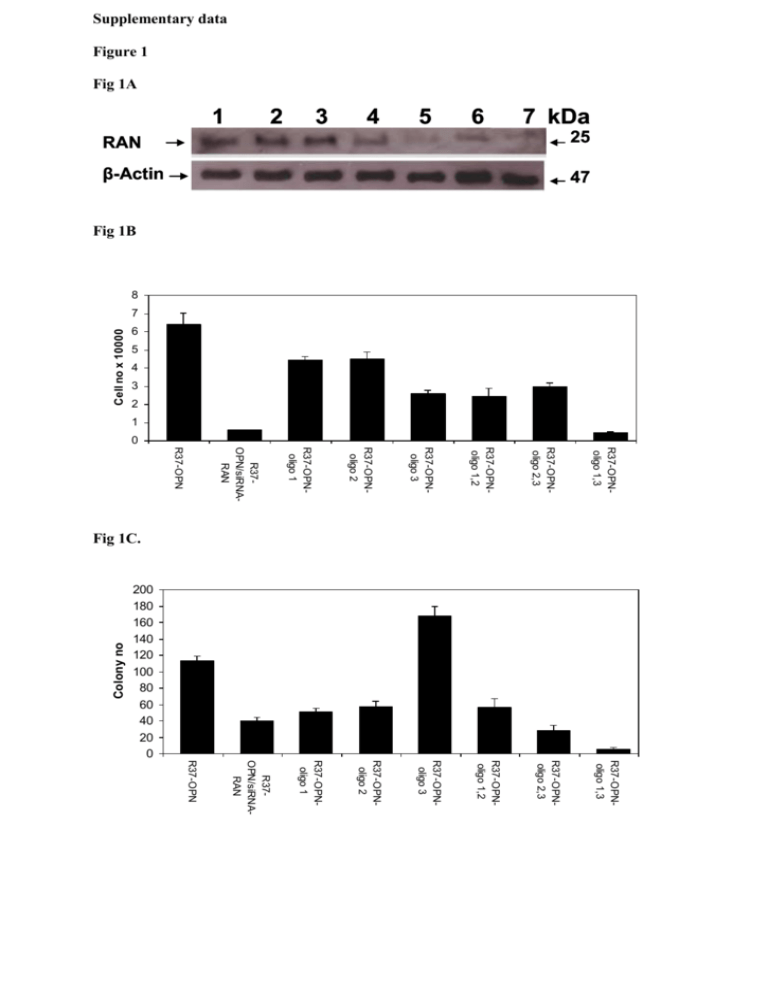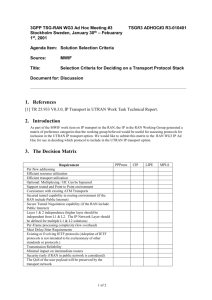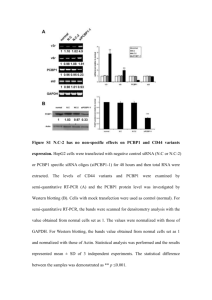Supplementary data Figure 1 (doc 407K)
advertisement

6 5 4 3 2 Cell no x 10000 7 kDa 6 5 4 3 2 1 RAN 25 β-Actin 47 R37-OPNoligo 1,3 R37-OPNoligo 2,3 R37-OPNoligo 1,2 R37-OPNoligo 3 R37-OPNoligo 2 R37-OPNoligo 1 R37OPN/siRNARAN R37-OPN 200 180 160 140 120 100 80 60 40 20 0 Colony no Supplementary data Figure 1 Fig 1A Fig 1B 8 7 1 0 Fig 1C. R37-OPNoligo 1,3 R37-OPNoligo 2,3 R37-OPNoligo 1,2 R37-OPNoligo 3 R37-OPNoligo 2 R37-OPNoligo 1 R37OPN/siRNARAN R37-OPN Fold Induction Fig.1D 1.4 1.2 1 0.8 0.6 0.4 0.2 0 pM 1 VP p + n 6 pM -O Ra 61 P pV + PN + n Ra 61 P pV pM VP +p 16 PN -O pM Fig.1 The expression and biological effect of each oligonucleotide combination to RAN from the siRNA library A Immunoblot for RAN protein with R37-OPN cells transfected with individual siRNA-RAN oligonucleotides. Cell lysates were diluted and 5µg loaded onto a SDS 10% (w/w) polyacrylamide gel, as follows: lane 1 R37-OPN; lane 2 R37-OPN-oligo 1; lane 3 R37-OPN-oligo 2; lane 4 R37-OPN-oligo 3; lane 5 R37-OPN-oligo 1,2; lane 6 R37-OPN-oligo 2,3; and lane 7 R37-OPN-oligo 1,3. Specific proteins were detected using antibodies to RAN or -actin. Bands were quantified using densitometric analysis and normalised with respect to those of β-actin. The results were a representative sample of three experiments. There was no change in the level of OPN protein. B The ability of stably transfected cell lines to adhere to a laminin treated surface was assessed over a 30 min period and the number of adherent cells quantified. All three oligonucleotides from the siRNA RAN mixture were stably transfected separately into the R37-OPN cell line. The results were the mean ± standard error of three independent experiments. C Soft agar assays were carried out to asses the ability of stably transfected cell lines to grow in an anchorageindependent environment. The colony number was assessed after 5 days. The results were the mean ± standard error of three independent experiments. The expression of three separate siRNA oligonucleotides targeted against RAN inhibits the three properties associated with the malignant, metastatic state in R37-OPN cells to varying degrees. This result is consistent with RAN being a downstream effector of the same malignant, metastatic state induced by OPN. This conclusion is confirmed by the similar incremental decreases in expression of RAN protein (Fig. 1A) and in cell adhesion (Fig. 1B) and anchorage-independent growth (Fig. 1C) when the R37-OPN cells are transfected singly or in binary combinations with the three siRNA oligonucleotides targeted against RAN. D Mammalian two-hybrid assays to detect interactions of OPN with Ran. Rama 37 cells were transiently cotransfected using pVP16-Ran or pVP16 plasmid with pM-OPN or pM plasmid. A reporter plasmid pG5-CAT was included in all co-transfections. All co-transfections also contained pSV40-β-Galactosidase expression vector, which worked as a β-galactosidase internal control reporter to normalize for transfection efficiency. Forty-eight hours after transfection, the transfected cells were collected and CAT enzyme assay was performed. Fold induction was performed compared to the cells cotransfected with empty pM and empty pVP16 vector for all the CAT assay result. Experiments were performed in triplicate. Values are means with S.D. from triplicate independent determinations. * p>0.05 compared to cell cotransfected with pM-OPN and pVP16-Ran.







